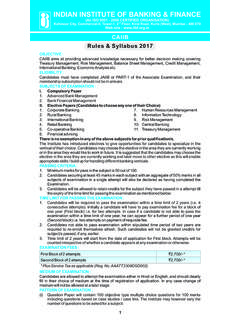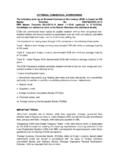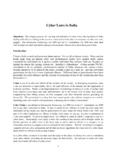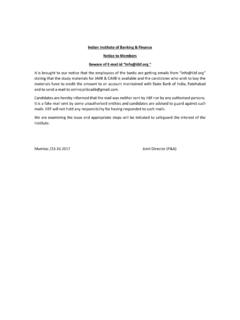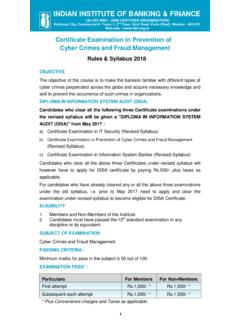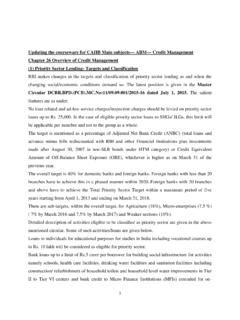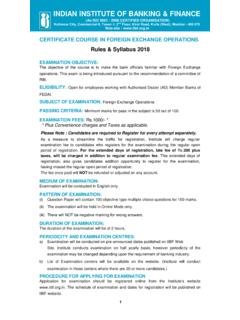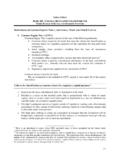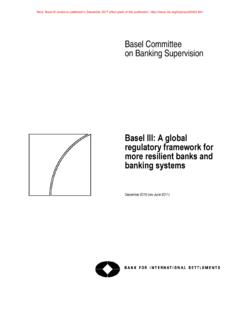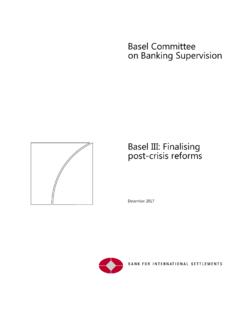Transcription of Basel III & its implications - IIBF
1 1 Bank Financial Management Additional Reading Material Module D Basel III & its implications Introduction: John Kenneth Galbraith, famous Harvard economist and the US ambassador to India during Kennedy s administration wrote: All financial crises are the result of debt that, in one fashion or another, has become dangerously out of scale . This was clearly demonstrated in the financial crisis which took place in the US in 2008. Aggressive lending characterized by sub-prime housing loans and excessive leverage in major banks and financial institutions led to the most serious financial challenge since the Great Depression of 1930s. The Sub Prime Crisis had reportedly led to a total write off of trillion dollars. One has to understand the causes of the financial crisis and take appropriate measures to avoid its recurrence.
2 In order to withstand such a shock in future, the Basel Committee on Banking Supervision (BCBS) has announced on September 13, 2010, new capital rules as agreed by the global regulators. The new requirement, known as Basel III, demands a substantial strengthening of existing capital requirements. This involves higher global minimum capital standards for banks. As cited above, Basel III reforms are the response of BCBS to improve the banking sector s ability to absorb shocks arising from financial and economic stress, whatever the source, thus reducing the risk of spill over from the financial sector to the real economy. During the Pittsburgh Summit in September 2009, the G20 leaders committed to strengthen the regulatory system for banks and other financial firms and also act together to raise capital standards, to implement strong international compensation standards aimed at ending practices that lead to excessive risk-taking, to improve the over-the-counter derivatives market and to create more powerful tools to hold large global firms to account for the risks they take.
3 For all these reforms, the leaders set for themselves strict and precise timetables. Consequently, the BCBS released comprehensive reform package entitled Basel III: A global regulatory framework for more resilient banks and banking systems (known as Basel III capital regulations) in December 2010. (Source: RBI) Basel III reforms strengthen the bank-level micro prudential regulation, with the intention to raise the resilience of individual banking institutions in periods of stress. Besides, the reforms have a macro prudential focus also, addressing system wide risks, 2 which can build up across the banking sector, as well as the pro-cyclical amplification of these risks over time. These new global regulatory and supervisory standards mainly seek to raise the quality and level of capital to ensure banks are better able to absorb losses on both a going concern and a gone concern basis, increase the risk coverage of the capital framework, introduce leverage ratio to serve as a backstop to the risk-based capital measure, raise the standards for the supervisory review process (Pillar 2) and public disclosures (Pillar 3) etc.
4 The macro prudential aspects of Basel III are largely enshrined in the capital buffers. Both the buffers the capital conservation buffer and the countercyclical buffer are intended to protect the banking sector from periods of excess credit growth. (Source: RBI) Reserve Bank issued Guidelines based on the Basel III reforms on capital regulation on May 2, 2012, to the extent applicable to banks operating in India. Banks have started implementing the guidelines from April 1, 2013 in India in a phased manner. Banks are advised by RBI to report the CRAR as per Basel II and Basel III simultaneously in all their disclosures to the stakeholders. The Basel III guidelines are expected to be fully implemented by March 31, 2019. Comparison between the Basel Guidelines: Basel I Basel II Basel III Basel Committee on Banking Supervision (BCBS) had come out with these guidelines in the year July, 1988 as a solution to mitigate the Herstatt Risk that took place in the year 1974 due to collapse of the German Bank.
5 By definition, recognized only the Credit risk as the potential risk for the failure of the Banks. Subsequently, BCBS came out with Market Risk paper in the year 1996 a set of rules to strengthen the treasury operations of BCBS came out with these guidelines in the year June 2004 to overcome the inadequate risk measurement approach of Basel I arising out of the changed banking scenario more due to technology adoption. Besides, credit & market risks, recognized the following additional risk: o Operational Risk. The Credit risk of Basel I was completely revamped and Basel II adopted a risk-based approach. Also BCBS came out with this Consultative Paper on 13th September 2010 as a fall out of Sub-Prime Crisis of US, which later on became a contagion effect and resulted into a global crisis.
6 As stated above, Basel III calls only for additional capital for the Banks to withstand the global shocks such as Sub-prime crisis in the future. 3 Basel I Basel II Basel III the banks. This was necessitated out of Nick Leeson Fraud, due to which the world saw the collapse of Barings Bank Ltd. introduced risk mitigation techniques as Basel I did not recognize the role of credit risk mitigants, such as credit derivatives, securitizations, collaterals and guarantees in reducing the credit risk. Why Basel III? o According to BCBS, the Basel III guidelines aim to improve the banking sectors ability to absorb shocks arising from financial and economic stress. o In short the objectives of Basel III are: Strengthening of resilience of the banking sector against future shocks.
7 Supplementing the current recovery process. Reducing the risk spillover effect of a financial crisis to the real economy. o The new Basel III requirement demands bank s to hold top quality capital totaling 7% of the risk weighted assets. o The sigh of relief for the Banks is that the guidelines have given long lead-time and graded approach for the banks to bring/raise the capital. o The tier 1 capital ratio would require banks to hold 7% common equity including of Capital Conservation Buffer. Capital Conservation Buffer (CCB): o The CCB is designed to ensure that banks build up capital buffers during normal times ( outside periods of stress) which can be drawn down as losses are incurred during a stressed period. The requirement is based on simple capital conservation rules designed to avoid breaches of minimum capital requirements.
8 O Banks have been given time until 2019 and in case banks do not comply with the guidelines, and then they may not be allowed to declare/pay dividends to the shareholders. The drawdown table of CCB as given by RBI is given below: Minimum capital conservation standards for individual bank Common Equity Tier 1 Ratio after including the current periods retained earnings Minimum Capital Conservation Ratios (expressed as a percentage of earnings) 4 - 100% > - 80% > - 60% > - 40% > 0% o For example, a bank with a Common Equity Tier 1 capital ratio in the range of to is required to conserve 80% of its earnings in the subsequent financial year ( payout no more than 20% in terms of dividends, share buybacks and discretionary bonus payments is allowed) Source RBI.
9 The Tier 1 Capital should be in the nature of Going-Concern Capital, , Capital which can absorb losses without triggering bankruptcy of the Bank. The components of Tier 1 Capital is: o Common Equity Tier 1, which would broadly consist of Common shares (paid-up equity capital) Share Premium. Statutory Reserves. Capital Reserves representing surplus arising out of sale process of assets. Other disclosed reserves if any. Balance in Profit & Loss account at the end of previous financial year. Banks can also reckon the profits in current financial year for CRAR calculation on a quarterly basis provided the incremental provisions made for NPAs at the end of the four quarters of the previous financial year have not deviated more than 25% from average of the four quarters.
10 Revaluation reserves at a discount of 55% (This item was originally part of Tier II capital. RBI has brought the same under Tier I vide Circular of March 1, 2016). Foreign currency translation reserve arising due to translation of financial statements of their foreign operations in terms of Accounting Standard (AS) 11 at a discount of 25%. Deferred Tax Assets (DTAs) which related to timing differences (other than related to accumulated losses) can be recognized upto 10% of CET1. The DTA recognized portion + significant investments in the common shares of unconsolidated financial entities ( , banking, financial and insurance) taken together should not exceed 15% of the CET1. Banks instead of recognizing as part of CET1 upto 10% can net the same with associated Deferred Tax Liabilities (DTLs) subject to approval of tax authorities.

